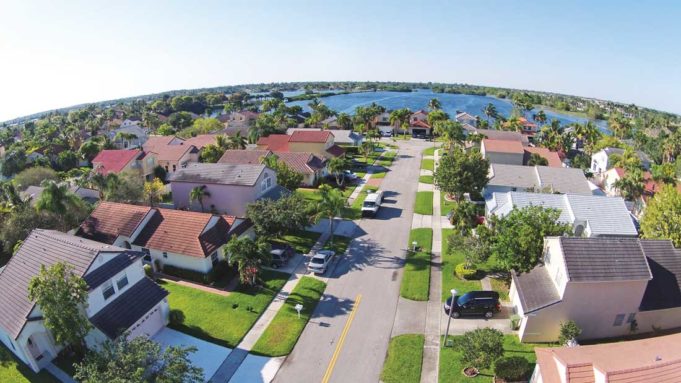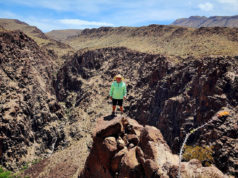I live in a large, planned middle-class community. There are catch-and-release ponds, swimming pools, parks, and ducks. Throughout the larger development are smaller communities. My neighborhood is off a heavily used street. It is a little cocoon of a few streets. The houses across the street back up to a pond. Children play in an open greenbelt.
My street runs north to south. At the south end, the street takes a sharp turn to the right. There is not a stop sign. It is a sharp turn. Across the street, at the turn, there is an indentation. It is not a cul-de-sac or a small turnaround. It is a small indentation to compensate for the sharp turn. There are always three to four cars or trucks parked around it. Some of the cars never seem to move. Other cars come and go. Since the cars are parked around the sharp turn, it is a blind spot that makes the indention useless. I live a few houses north of the sharp turn. Whether I’m leaving home or returning home, I always slow down and scan the blind spot for oncoming traffic.
Last winter, jacket-weather winter for a Texan, I backed out of my driveway. Down the street but parallel to me is a driveway that I can see into directly. I was driving toward it when I saw something. Is that a snowman? Not a snow-snowman –– I live in Texas –– but a stuffed-animal snowman. I passed the house as I took the turn. The snowman, I realized, was a baby. I turned my car around. The baby started crawling to the street. No one was around. Not a parent. Not a babysitter. No one. He was alone. He was crawling to the street.
I picked him up. He had a big white head with no hair. He wore a dark jacket and light pants. This gave him a perfectly proportional body, which made me think snowman. He was a sturdy baby.
He started crying. I felt indignation. How dare someone abandon a baby? I didn’t know where he came from. I knocked on the door of the house attached to the driveway. A pre-teen boy answered. The baby, he said, was his little brother. Where are your parents? His mother came to the door. I said I found your baby in the driveway. She said, “Thank you. We have a lock, but the kids are going in and out.”
There was no emotion in her response. Just “thank you.” The way someone would act if her mail was mixed in with yours. I said, “You realize your baby was crawling to the street.” She said, “Yes, thank you.” Wait. I made the statement several times by adding different inflections. You realize that the baby was crawling to the street. Yes, thank you. You realize that the baby. Was. Crawling. To the street. Yes, thank you.
Everyone responds differently in stressful situations. The mother showed no emotion. Her baby, crawling to the street. She didn’t know he was missing. She didn’t ask what happened. She didn’t do what I would have done, which would have been to fall to the floor crying hysterically. She didn’t ask my name. Thank you and shut the door.
Judging this event from the outside is easy. When I relay the story to others, I’m always asked the same question: Did you call Child Protective Services? Without a doubt, calling the authorities would have been the correct response. Call 911 and CPS. Who finds a baby in a driveway? My reaction inside was indignation. How dare you? I believe the shock was bigger in my brain than “call 911.” A traumatic event happens in a few small minutes. Between the unattended, crying baby, the indignation, and the non-responsive mother, I was rattled.
It was a struggle for a few weeks, my brain stuck on “What if?” Any deviation from the actual timing of my finding the baby was a potential tragedy. He was crawling. He was low to the ground. Would I have seen him coming from a different direction? I always drive slowly down the street. I pay attention to the road. Enough, brain. The baby was a snowman beacon. I was meant to find him. He was safe.
I didn’t see the baby again until summer. Then I saw him a bunch. All summer long, the mother was in the indentation, the blind spot section of the street. She was with small kids and tweenaged kids on tricycles, scooters, bicycles. From time to time, they were in the yard. Most of the time, they were in the street. All summer long, kids playing in the blind spot of the street. Drive down the street. Stop. The mother moves everything out of the way. Continue driving. Sometimes the older kids were playing with the baby. No mother to be seen. The frustration was not unique to me. It was a problem for a lot of other neighbors.
All summer, my emotions went from the initial indignation of finding the baby, to weariness over the playing in the street, back to indignation for playing in the street. Day after day in the street. This family parked a large truck in the driveway. In my parenting world, move the truck, ride in the driveway, play in the yard.
Many times, I passed the baby, the children, and/or the mother. My thought was “I messed up.” I should have contacted the authorities. At that point, I felt it was too late to fix it. Too much time had passed. Calling 911 would be foolish. My window for calling CPS was closed. Or so I thought.
One day, I left my house. In the street, behind the enormous truck, were riding toys, scooters, bicycles, and tricycles. The curve is barely wide enough for a car. Hitting a toy would damage a car. I stopped at the house. I asked the mother if she knew who I was. “No?” I told her it is dangerous for drivers, who could run over a toy. The toys needed to be removed from the street. People don’t want to damage their cars.
Summer wound down. School started. The Texas temperature was still in the 90s. The blind spot was still a hazard. Day after day, in the street, the baby, the bigger kids, scooters, tricycles, and bicycles. Driving became drudgery. Stop. Wait for the mother to move children and toys out of the street. Repeat. It was wearing on me.
 A few days before Thanksgiving, I returned home later in the afternoon. I turned onto my street. I shook my head. This can’t be happening, again. Right in front of me, where the street and the driveway meet, stood the baby. He was alone. He was wailing. It was not a normal cry but a disconcerting wail.
A few days before Thanksgiving, I returned home later in the afternoon. I turned onto my street. I shook my head. This can’t be happening, again. Right in front of me, where the street and the driveway meet, stood the baby. He was alone. He was wailing. It was not a normal cry but a disconcerting wail.
I stopped my car. I called 911. The baby ran to the front door. He began to wiggle the front door handle. Wailing and wiggling the handle. The wailing was distressing. The father opened the door. The baby ran into the house.
I said, “How many times must I find your baby outside alone?” The father ran out the door after me. He was screaming. “Leave me and my family alone!” “The bigger kids watch the littler kids!” “Get off my property!”
I’m the enemy, except I’m not. Ultimately the responsibility for the baby belongs to the parents, not the older kids, not to me. The father was shifting blame to me for protecting the baby. The parents weren’t abusive. They were neglectful. Which can be even worse. As TCU child expert Karyn Purvis has said: Abuse says, “I don’t like you.” Neglect says, “You don’t exist.” The idea of responsibility, in this situation, is a societal issue. A baby is outside alone crawling to the street. Whoever sees the baby is responsible for removing him from harm’s way.
After filing the police report, I made the call to CPS. The intake specialist spent time helping me to calm down and not worry. Finding the baby in the driveway a second time was shocking. I reported all three incidents plus the constant playing in the street. The toys everywhere. The hazard of the blind spot. I couldn’t carry this burden any longer. It did not belong to me. I found the baby, twice. Two times, unsupervised.
A CPS worker did visit the family that night. Within a few weeks, I received a letter from CPS. “Their investigation is complete. They will not be offering services to the family.” What? What is the “baby alone outside” cutoff? Did I need to find the baby three times? Did the baby need to be dead?
CPS in Texas is a program in crisis. Caseworkers carry more than the recommended load. I wonder if CPS has a triage process. The baby didn’t make the cut. The State of Texas approved an emergency grant to hire 800 more caseworkers and give raises to current employees. The initiative is to prevent children from slipping through the cracks. The emergency grant went into effect December 1. It will take months to complete the initiative.
Child Protective Services failed the baby by refusing to provide services. Child Protective Services failed every driver on the street. The facts are the baby has been outside and alone, at least twice. Have there been other incidents? I couldn’t drive down the street the only two times the baby has been unattended. All summer and fall, the baby has been in the street. He is on his riding toys. His mother taught him it is alright to be in the street. So where will the baby be when he is outside?
What if the worst possible outcome had been the outcome? A tragedy happens. Killing a baby would be a gut punch that hurts with every movement. Blame and self-hatred would prick at the arms and legs and the heart. People looking in at the situation would censure the person who killed the baby, even if it was an accident. The sympathy would be with the family.
 What if the worst possible outcome happens now? I have found the baby outside, alone, twice. The parents have a documented complaint of neglect with CPS. There is a documented letter from CPS refusing to provide services. Would there be finger-pointing at CPS? Would there be outrage at the parents of the baby? Now, the story is different. An accident that could have been prevented. The authorities knew the baby was outside alone, at least twice. The authorities took no action.
What if the worst possible outcome happens now? I have found the baby outside, alone, twice. The parents have a documented complaint of neglect with CPS. There is a documented letter from CPS refusing to provide services. Would there be finger-pointing at CPS? Would there be outrage at the parents of the baby? Now, the story is different. An accident that could have been prevented. The authorities knew the baby was outside alone, at least twice. The authorities took no action.
I wondered about the legal ramifications for this type of accident. Would the innocent person who “got in the way of the baby” face legal charges? Would the charges be different if the accident occurred before I found the baby? After I found the baby, there would be documented proof that the parents were neglectful.
The State of Texas’ penal code defines manslaughter as, “A person commits an offense if he recklessly causes the death of an individual.” The code defines “recklessly” as a lot of legal jargon that I’m summarizing as, “A person is aware of his conduct but consciously disregards a substantial and unjustifiable risk that the circumstances exist or the result will occur.”
Given the statutes, it seems reasonably certain that the driver would not be charged. The driver should not be charged. Legal charges are not the same as living with yourself after a horrible accident. Time doesn’t heal all wounds.
The family began to harass me. Not too long ago, I was in the front yard with my grandchildren. Two kids rode their bikes on the sidewalk across the street. They came from the indentation area. They stopped right before they would be directly across from my house. One of the kids started screaming at me. Screaming at me in front of my very small grandchildren. A little boy screaming, “We’re leaving, and we’re never coming back!”
I took my grandkids back in the house. It was not safe outside. Another situation where these parents allow their unsupervised children to run the neighborhood. Children mimic what they hear and what they have been told.
One evening, I walked down the driveway to my mailbox. The huge family truck was driving toward my house. At my mailbox, they slowed down to a crawl until they passed my house. I just smiled and waved. The second time I found the baby, I did what needed to be done. I did what I should have done the first time. No second guessing. No doubting my actions. If I find the baby again, I will call 911 and CPS.
I had one last thought. A sign to prevent parking around the sharp turn. Removing the blind spot would give drivers a better view of any hazards. Per the community center, this issue has come up. A lot. Three weeks before my call, there had been another complaint. The sharp turn is not a stop sign. It is the flow of the street. The cars are not parked illegally. If the cars are not street legal, they can be towed.
One final incident, “final” because they have moved. I had a grandchild for the day. We sat on the front lawn waiting for Mommy. I heard screaming, “Get out of the street! Get out of the street!” The father was standing on the sidewalk. The baby was riding a tricycle around and around the indention, the blind spot. When Child Protective Services chose not to offer services, they put a rubber stamp on those parenting skills. The takeaway, for the parents, was to make sure I didn’t see anything that would result in another call to CPS. Putting all that has happened aside, the takeaway for me: I found a baby in a driveway, twice. Both times, he was safely returned to his home.
Kate Cahill is a writer who lives in Fort Worth.












